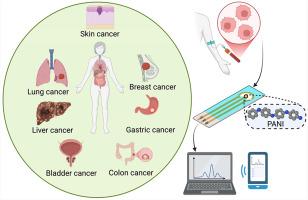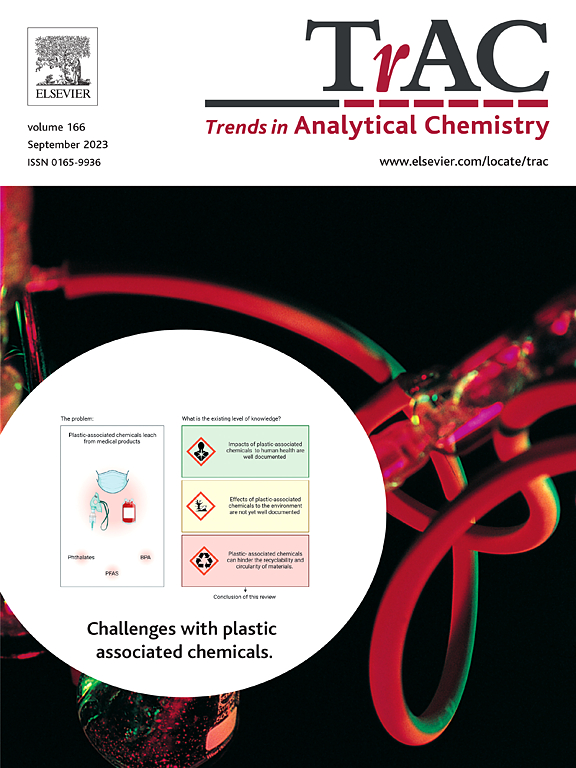Recent advancements in polyaniline-based biosensors for diagnosis of cancers: A comprehensive review
IF 11.8
1区 化学
Q1 CHEMISTRY, ANALYTICAL
引用次数: 0
Abstract
Recent advances in biosensor and bioelectronics technologies have revolutionized cancer diagnosis, providing more accessible, sensitive, and specific methods for early detection. This review focuses on polyaniline (PANI)-based biosensors, which demonstrate significant potential in detecting cancer biomarkers due to their tunable properties, cost-effectiveness, and ease of synthesis. Various PANI synthesis techniques, including chemical, electrochemical, enzyme-catalyzed, vapor-phase, and template-assisted polymerization, are examined, along with the development of multidimensional PANI nanostructures to enhance biosensor performance. Advanced 3D printing techniques have enabled the precise fabrication of PANI-based devices, such as flexible sensors, high-performance supercapacitors, and electroactive scaffolds, showcasing PANI's versatility and potential in biomedical and biosensor applications. The application of PANI-based biosensors in detecting lung, liver, breast, and prostate cancers is discussed, highlighting the detection principles, limits, and specificity for each cancer type. Furthermore, the role of PANI in signal amplification through nanocomposite (NC) integration, which improves diagnostic accuracy, is explored. This comprehensive review also addresses the current challenges and future opportunities for advancements in PANI-based biosensor technology, emphasizing its critical importance in the next generation of cancer diagnostics. By overcoming the limitations of conventional diagnostic methods, these biosensors are positioned to play a pivotal role in improving early cancer detection and patient outcomes.

用于诊断癌症的聚苯胺基生物传感器的最新进展:综述
生物传感器和生物电子学技术的最新进展彻底改变了癌症诊断,为早期检测提供了更便捷、灵敏和特异的方法。本综述重点介绍基于聚苯胺(PANI)的生物传感器,由于其可调的特性、成本效益和易于合成的特点,这种传感器在检测癌症生物标志物方面具有巨大的潜力。本研究考察了各种 PANI 合成技术,包括化学、电化学、酶催化、气相和模板辅助聚合,以及多维 PANI 纳米结构的开发,以提高生物传感器的性能。先进的三维打印技术实现了基于 PANI 的器件的精确制造,如柔性传感器、高性能超级电容器和电活性支架,展示了 PANI 在生物医学和生物传感器应用领域的多功能性和潜力。报告讨论了基于 PANI 的生物传感器在检测肺癌、肝癌、乳腺癌和前列腺癌中的应用,重点介绍了每种癌症的检测原理、极限和特异性。此外,还探讨了 PANI 通过纳米复合材料 (NC) 集成在信号放大中的作用,从而提高了诊断的准确性。本综述还探讨了基于 PANI 的生物传感器技术当前面临的挑战和未来的发展机遇,强调了该技术在下一代癌症诊断中的关键重要性。通过克服传统诊断方法的局限性,这些生物传感器将在改善早期癌症检测和患者预后方面发挥关键作用。
本文章由计算机程序翻译,如有差异,请以英文原文为准。
求助全文
约1分钟内获得全文
求助全文
来源期刊

Trends in Analytical Chemistry
化学-分析化学
CiteScore
20.00
自引率
4.60%
发文量
257
审稿时长
3.4 months
期刊介绍:
TrAC publishes succinct and critical overviews of recent advancements in analytical chemistry, designed to assist analytical chemists and other users of analytical techniques. These reviews offer excellent, up-to-date, and timely coverage of various topics within analytical chemistry. Encompassing areas such as analytical instrumentation, biomedical analysis, biomolecular analysis, biosensors, chemical analysis, chemometrics, clinical chemistry, drug discovery, environmental analysis and monitoring, food analysis, forensic science, laboratory automation, materials science, metabolomics, pesticide-residue analysis, pharmaceutical analysis, proteomics, surface science, and water analysis and monitoring, these critical reviews provide comprehensive insights for practitioners in the field.
 求助内容:
求助内容: 应助结果提醒方式:
应助结果提醒方式:


